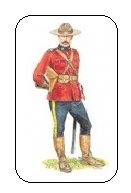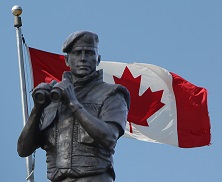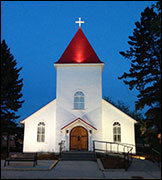True and Fascinating Canadian History
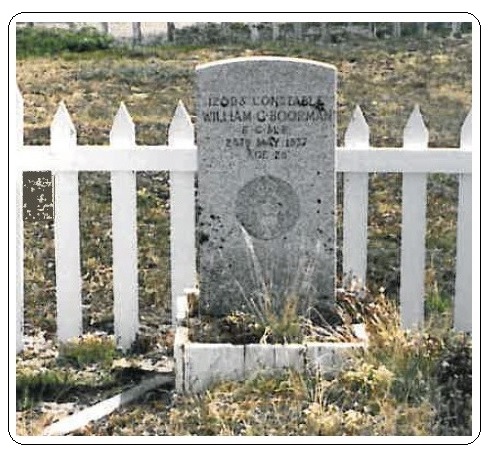
Vet of the Month: November, 2017
Reg.#12093, Constable William George Boorman
Honour Roll # 61
RCMP Vets. Ottawa, ON

As an 'ole retired RCMP Officer, an invitation out for coffee or lunch is mostly routine. And by the time I have arrived to meet my friends I already know the previous night's hockey scores and whether or not the TSE was up or down. It seems that hockey and the Toronto Stock Exchange are the chief topics of greying retirees.
But a couple months ago, I was greatly surprised when I received an unusual message from Ms. Marilyn Torrance who explained her discovery of some personal papers which once belonged to Reg.#12093, Constable William George Boorman. Ms. Torrance said, "I was going through some of my mother's personal items in a storage locker in Winnipeg, MB when I came across a lengthy document -- it was a 27 page typed personal account by Constable Boorman and it described his voyage from Montréal, QC., to Port Harrison, QC beginning on Tuesday July 14th, 1936 and up to Monday August 3rd, 1936 while on board the RMS Nascopie. The sea voyage included stops at the Hudson Bay Company and inspections of RCMP posts along the way." Indeed! What a precious discovery, I thought.
I immediately agreed to meet Ms. Torrance and I placed a very high priority on this not so ordinary coffee rendezvous.

After I met Ms. Torrance, it became more clear to me about her close family connection to Constable Boorman. Ms. Torrance explained this unique relationship, she said, "...the old locked steamer trunk in Winnipeg belonged to my aunt, Mary Dakin (nee Brown) and at the time of his death, Billie Boorman and my aunt Mary were engaged to be married, hence the Boorman link to my family." At once, I felt very sad thinking about Constable Boorman's unfortunate death in 1937 and the loneliness which his loss must have caused for Mary Dakin for the remainder of her life.
The following story is dedicated to Constable William George Boorman. He is listed on the RCMP's Honour Roll as #61. Constable Boorman died after his rifle discharged accidently and killing him in 1937 while seal hunting near Elsie Island which is about forty five miles northeast of Inukjuaq (formerly known as Port Harrison) in the eastern area of Hudson Bay, Nunavik (northern Québec), Canada.

William George Boorman joined the RCMP on November 15th, 1933. After a short stint at 'Depot' Division forBasic Recruit Training, Constable Boorman was first transferred to British Columbia. It is not known if Constable Boorman showed some particular interest in the Arctic, but after a couple of years in BC, an opportunity arose for him to make the three weeks voyage one way aboard the Nascopie.
Only three brief references are made to other RCMP members in Constable Boorman's report; an unidentified constable, a Constable Turner and an Inspector Duncan. It appeared from the report that the unidentified constable would stay temporarily at Hebron (along the Labrador coast), Constable Turner would be dropped off at Lake Harbour and Constable Boorman would be left when the Nascopie reached it's final stop at Port Harrison, QC. Along the water route to Port Harrison, it was the RCMP team's responsibility to inspect Detachments whenever the Nascopie stopped along the east coast. In all probability, Inspector Duncan returned to Montréal with the Nascopie after depositing the unidentified constable, Constable Turner and Constable Boorman at their respective isolated posts.
In the short story which follows, Constable Boorman's report of 1937 is summarized in remembrance of him. I want to acknowledge and sincerely thank Ms. Torrance for giving me a copy of Constable Boorman's report. It is a very worthy, historical and insightful RCMP document.
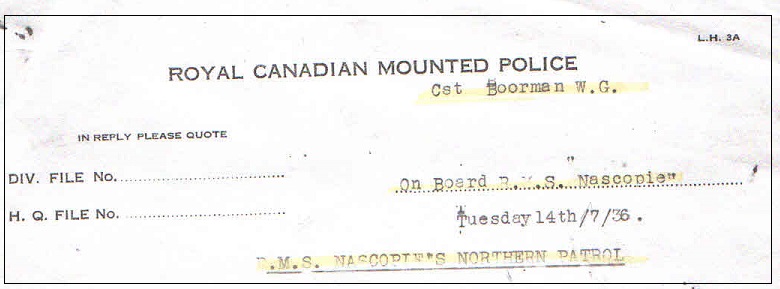
Tuesday, July 14th, 1936. "In Montréal, I was up at 6:30AM, and put on board the Duty Truck and driven to Pier 6 just in time for the gang plank to be pulled in -- bells sounded for departure eastward, out of Montréal and down the mighty St. Lawrence and onward to the sea. What a thrill after having spent so many years on the windswept prairies with an interlude of a few months through the Rockies and a year at the extreme Western coast to find oneself at last steaming down one of the greatest waterways in the world."
Wednesday, July 15th, 1936. "What a breakfast awaited all the passengers...every variety of cereal, fishwith a choice of other dishes so the cook deserved to be complŇmented. By noon, we had reached the Belle IslandStraits then on to the mouth of the St. Lawrence - I had time to recall my days at 'Depot'...having been chased from pillar to post answering 'Sir', grooming those long faced quadrupeds and eating dust...it was grand to lie in the sun just to reminisce."
Thursday, July 16th, 1936 - "We spent the day in fog."
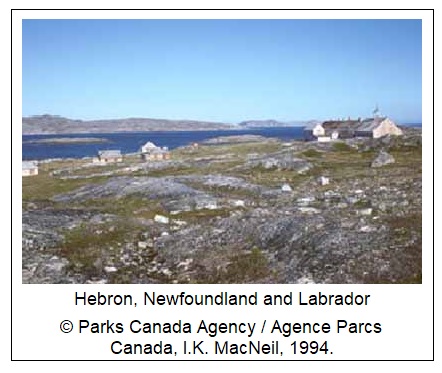
Friday, July 17, 1936. "More fog and for the first time we felt the swell of the Atlantic which made the passengers sick."
Saturday, July 18th, 1936. "There were fewer people for breakfast, I laid placidly in my bunk until the effects of the sea more or less passed."
Sunday, July 19, 1936. "More fog. Visibility poor. During the day I watched a motion picture and played some bridge games."
Monday, July 20th, 1936. "The Nascopie stopped during the night due to fog. Little progress was made. Eventually, we reached Hebron along the Labrador Coast."
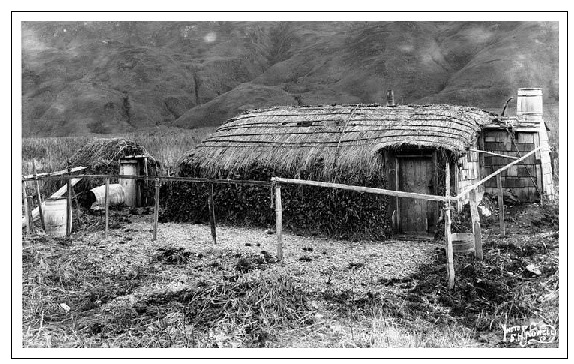
Tuesday, July 21, 1936. "We went ashore at Hebron and we were greeted by Eskimos women, children and mangy Huskies...the dogs at this time of the year are in very poor condition as food is quite hard to get so the Eskimos let them shift for themselves as best they can. Scattered along the shore line were the huts of the Natives these were the most depilated forms of structure possible, but never the less these homes house as many as six or seven families. The outside measurements are in the neighborhood of about seven by ten feet, so well can be imagined the way in which these people live, within these unclean abodes the meals are eaten, skins scraped and the general duties carried on.
The total native population is about one hundred and seventy five souls, all housed within fifteen dwellings; refuse is thrown to the ever hungry dogs who lounge around the exterior of the buildings. The first impression one gets of so many natives coming out of such a small dwelling is that the undoubtedly have solved the question of the high cost of living.
When evening came the Eskimos came aboard to entertain us with musical talents. This is a custom to invite the natives aboard every year the Nascopie comes to port. We stood on the upper decks watching these people demolish plate after plate of bully beef, lard and bread, what they couldn't cram in their mouths and stomachs they packed into their parka hoods and pockets, grease and all."
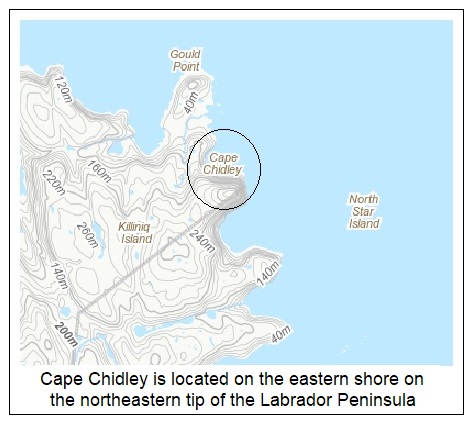
Wednesday, July 22, 1936. "After leaving Hebron the weather was fine until about six o'clock when the fog settled down barring all scenery from view. At eight thirty pm we were lying 15 miles off Cape Chidley. If the fog clears at all we should be in the harbour at Port Burwell at daybreak the 23/07/1936."
Thursday, July 23, 1936. "Morning found us still steaming north with the fog clearing somewhat. At 1:30 p.m. we dropped anchor in the harbour, just outside the post. The scenery was practically the same, a rocky barren coastline with very few flowers dotting the slopes. Landing we scrambled upon the rocks that were quite slippery owing to the seaweed which clung to the crevices of the rocks, at the top of this stair like formation of rock was a shelf of snow, a remark was passed, "Isn't it remarkable that there would be so much snow in July 24th.
Along the sidewalk to the west stood the R. C. M. P. building two store rooms a guard room and the living quarters four buildings in all, on either side of this gully on which the buildings run a clear mountain stream trickles to the rear of the of the R. C. M. P. quarters and upon the slopes great shelves of snow still lay.
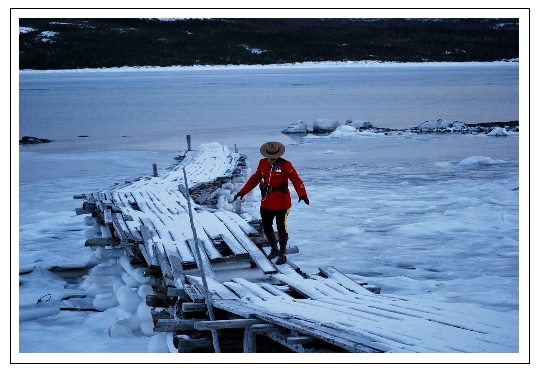
The R. C. M. Police buildings viz the living quarter was a great one story building consisting of three rooms, a storeroom or pantry with cupboards on one wall in the kitchen in one corner of this room stood a Quebec Heater rusty and very badly worn, on the floor carpets were laid adding a little more coziness to the surroundings, in the other room off from the kitchen a fireplace stood, writing desk and tables, this place was used for office, bedroom, and sitting room alike. The other buildings consisted of a guard room, storehouse and blubber shed, all toll the post consisted of eight buildings.
The R. C. M. Police detachment was in sorry need of cleaning so we shed our jackets and prepared for work, the living quarters of Burwell are to be town down so the furniture was moved to the guard room, this in turn being used by the man who is staying for the summer months until the return of the Nascopie."
Friday, July 24th, 1936. "We returned to the Detachment, much had to be done ashore taking stock, putting up the stove, scrubbing the floor, etc. making it comfortable enough for a person to live in, this took the better part of the day. In the afternoon the finishing touches were made and everything was left in ship shape order."
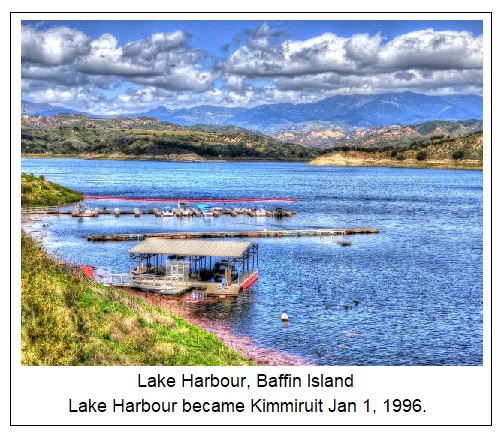
Saturday, July 25th, 1936. "This morning very little work was accomplished bar sweeping the floor and brewing a good pot of tea. Inspector Duncan checked stores and inspected the building, bynoon hour the detachment which is now only used as a reserve stove house instead of a permanent post was ready for use. Once back onboard, at 4:10 pm we pulled anchor and once more steamed out of Burwell Harbour. Twenty four hours hence if weather conditions permit we should be in Lake Harbour wherewe leave another one of the boys named Turner. The motto of the northern adventure of ours is Death warrant signed please deliver the body."
Sunday, July 26th, 1936. "Sunday morning loomed bright and beautiful with only a ripple on the sea, to our right the southern shore of Baffin Island lay...what a wonderful change in the surroundings,the air was invigorating the vessel seemed to just glide along...we have made exceptionally good time in crossing the straits, arriving one day ahead of schedule...but upon drawing ne ar we encountered millions of mosquitoes...it certainly dampened our spirits somewhat. Lake Harbour got its name from a large freshwater lake to the west of and situated at the rear of a brown limestone hill...
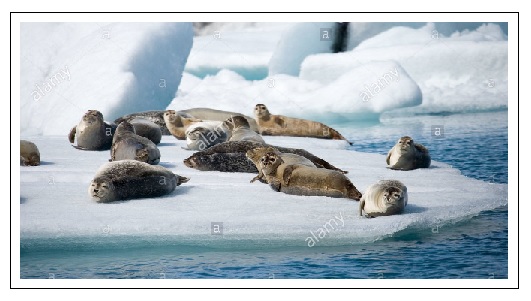
On the opposite side of the bay a little to the rear of a large crystalline lime stone hill, and situated some distance from the rocky shore line lay the R. C. M. P. Detachment. This Detachment was re-built by Corporal Dersch in 1926 and certainly is a credit to him, sandstone walks skirted by white-washed stones run to the entrance of every building. Just before entering these walks which connect the various store rooms and houses there is an archway with the R. C. M. P. letters made inwood and painted black at the top of this structure."
Monday, July 27th, 1936. "We went ashore again and spent the day exploring. This is by far the nicest post in the Eastern Arctic even after having explored as it were both sides of this bay still there was a lot to be seen..."
Tuesday, July 28th, 1936. "After leaving the native encampment we got aboard the RCMP boat which was rather a nice piece of work. Equipped with a 4 cycle Acadia Engine sails, etc., we made ourway across the bay to the northern shore where the R. C. M. P. buildings were. Two tents stood this housed the interpreter and his family, to the rear on a flagpole the Union Jack flew. This man is paid as the H. B. Co native by trade for the work he does around the detachment although his position really is manning the boat. All of our living quarters by the way are painted light grey with facings of dark grey with a black roof, what with the brown walkways, white stones and flowers on the slopes it sure was a grand picture to withhold.
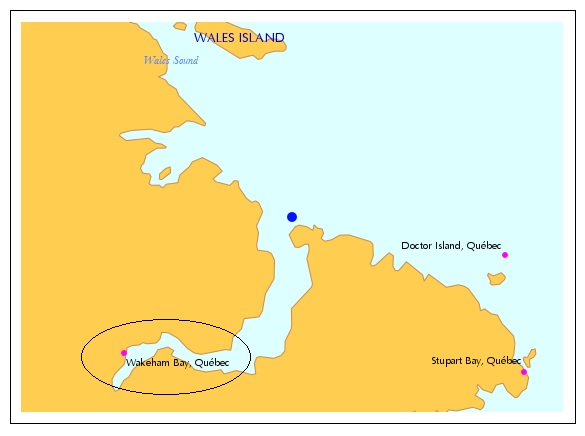
After the O. C. had inspected the buildings and upon our return to the Nascopie he remarked that he can see why it is so hard to get the men back to civilization, with all the comforts at hand and with no one to bother us (do hope this is true as would feel it was good time wasted). At five o'clock we pulled anchor steaming out to sea between these jagged pieces of land. By supper time wehad navigated the harbour and were passing the extreme tip of land. To our right lay an island called Big Island...in the water large pieces of ice with snow and again the occasional icebergs floated, awks and the odd seal were seen off the starboard side. At approximately 3:30 AM, a scraping notice was heard this was due to large cakes of ice in the harbour of Wakeham Bay."
"Wakeham Bay takes its name from Captain William Wakeham who, in 1897, lead an expedition to determine whether the Hudson Strait was safe for navigation. In 1961, the provincial government renamed the settlement Sainte-Anne-de-Maricourt, until with the establishment of a municipality it officially readopted its Inuktitut name, Kangirsujuaq." (Source: nunavik-tourism.com)
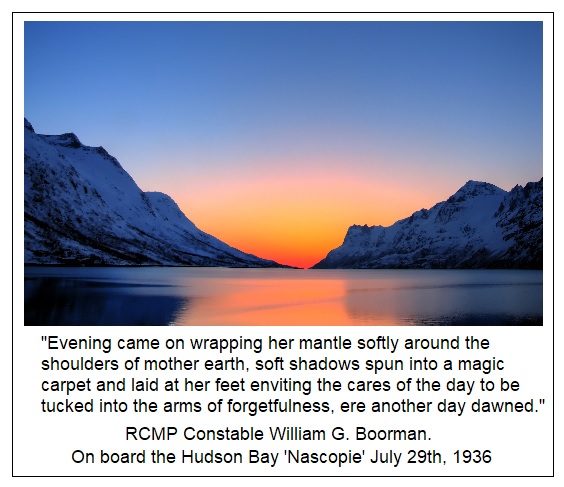
Wednesday, July 29th, 1936. "The passengers went ashore this morning, but returning to the vessel voiced their regrets in having done such a foolish thing, walking upon the grass roused million of mosquitoes making the tour instead of one which should have been enjoyed a very nightmare of flying tormentors.
Evening came on wrapping her mantle softly around the shoulders of mother earth, soft shadows spun into a magic carpet and laid at her feet inviting the cares of the cay to be tucked into the arms offorgetfulness, ere another day dawned."
Thursday, July 30th, 1936. "At 4 o'clock we pulled anchor with the bow pointing Northward steamed out of the harbour. Keeping close to the shore line as possible we came upon a little more ice than perusal, the sea now was as smooth as glass...as we pushed further on great fields of ice were met here the boat was cut down to 5 knots an hour...a walrus lay on an ice pan upon our approach took to the water, after this excitement had passed someone spied a polar bear we rushed amid ship to the port side and witnessed our first bear."
Friday, July 31st, 1936. This morning found us anchored at Sulluit another H. B. C. post. We went ashore here we were disappointed to find only two buildings and six or seven tents, this undoubtedly is the poorest post we visited. Upon reaching the foot of a hill we again encountered millions of insects but having foreseen this nuisance were well protected with handkerchiefs...by the time the boat arrived we were mighty glad to be aboard."

Saturday, August 1st, 1936. "At approximately 12 A. M. this morning we pulled anchor...we were drawing near the entrance of the harbour at Wolstenholme. Not going ashore today although some of the passengers went to witness a few marriages which were performed by the minister.
A funny thing about these ceremonies, the bride generally has two or three children of hers who attend the wedding, these rites have not been observed that is being married, until recently when civilization and the Gospel pushed further North, no less than six couples were married. And twelve baptisms performed, the minister had rather a busy day."
Sunday, August 2nd, 1936. "Morning loomed bright and beautiful with the bay like a sheet of glass. Another Sunday being passed on board a service was held at 10:30, changing and getting ready for dinner constituted our morning. The two sittings of dinner being cleaned away only gave us one hour to go ashore this in my estimation gave plenty of time to see the post and natives. Embarking at 2 P.M. upona very rocky beach proceeded to walk along the coast to where the H. B. post stood. When we reached the post we went inside and inspected the various rooms, everything was fine...Our decision was made this was the cleanest post yet. By 4 P. M. we were heading out the harbour into the bay our next stop should be Cape Smith a good 12 hour run from Wolstenholme."
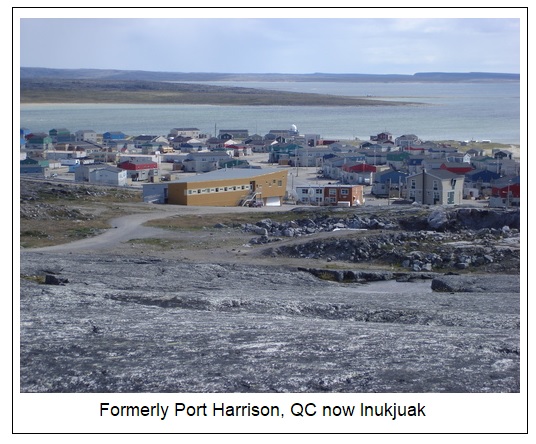
Monday, August 3rd, 1936. "During the early hours of the morning we stopped twice due to fog and the odd ice field, this making our trip between the two posts of longer duration than we expected. At 12 o'clock after 3 or 4 hours of very bleak scenery and rain we dropped anchor one mile from the post. Here thereis no harbour or bay, the post is located on the very edge of the water and must be a very cold and dismal spot as there is no shelter from the North or West winds.
When we docked the men took the supplies from the boat and placed them on shore, from here they are carried by the women and girls up to store houses. One remarkable incident we observed was that the women tugged and pulled these cases at times with the children on their backs. It is marvelloushow contented these youngsters are although being tossed around so, and it is strange that they do not fall out when the women stoop to pick up the boxes, the children who are being carried content themselves by playing with their mothers plait of hair.
This evening in the saloon a concert was given which included violin, accordion solos, and songs poetry and readings, in all an hour and one half was spent there was a very enjoyable one indeed.
After having a well spent day to night we pulled anchor again and in two days if no unforeseen obstacles are met with we should be in (Port) Harrison on the fifth two days ahead of schedule."
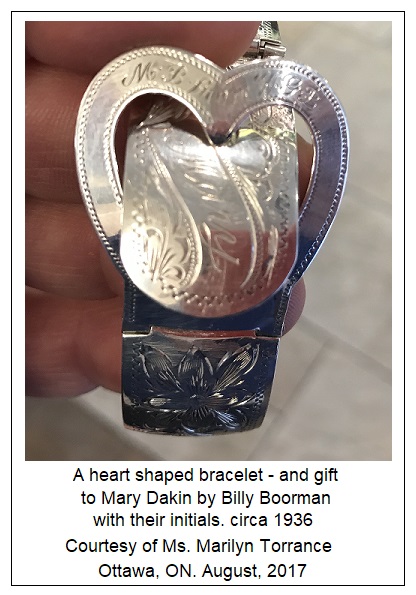
And so ended the 21 day voyage of Constable William G. Boorman and other members of the RCMP from Montréal, QC., to Port Harrison, QC. Their trip began on Tuesday July 14th, 1936 and it ended on Monday August 3rd, 1936 and all the while on board the RMS Nascopie.
Although Constable Boorman said that his final destination on the Nascopie was Port Harrison, he also inferred that he would remain at Port Harrison, QC to work among the Inuit until the Nascopie returned after another year or so. He was expected to arrive in Port Harrison about August 5th, 1936, but he died accidentally on May 26th, 1937 -- only a short nine month span after his arrival at Port Harrison. R. I. P.
Looking back, it is all to our benefit that Constable Boorman left us his daily diary. His description of life aboard the Nascopie, the people of the north and their mode of life, the accurate and colourful details which he provided of the sea with its calmness and its roughness, the surrounding shores and mountains, the various Hudson Bay posts and the RCMP Detachments which were inspected and improved by his efforts all leave us with rich images of the life which he saw and lived in the eastern Arctic.
Accompanied by Special Constable Sampson, Constable William George Boorman and four Inuit spent May 26th, 1937 seal hunting near Port Harrison, NWT. At the close of the hunt, Constable Boorman returned to their boat and as he placed his rifle in the boat it unexpectedly discharged. Constable Boorman was killed instantly.
I also want to thank Ms. Torrance for showing me the engagement ring and the heart shaped bracelet which Constable Boorman had once given to Mary Dakin in anticipation of their wedding.
We are indebted to Constable W. G. Boorman and we thank him for the memories.
Reporting from Fort Healy,
J. J. Healy
November 23, 2017
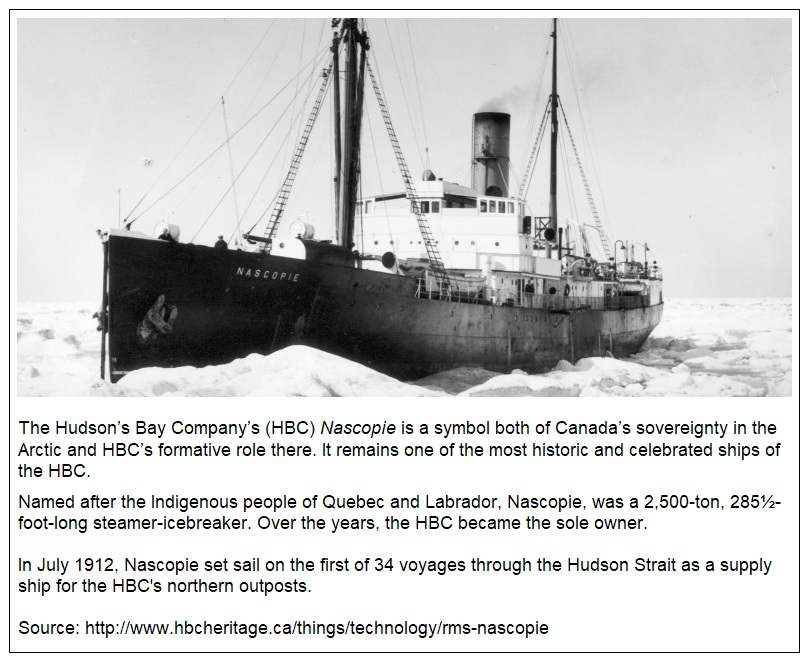
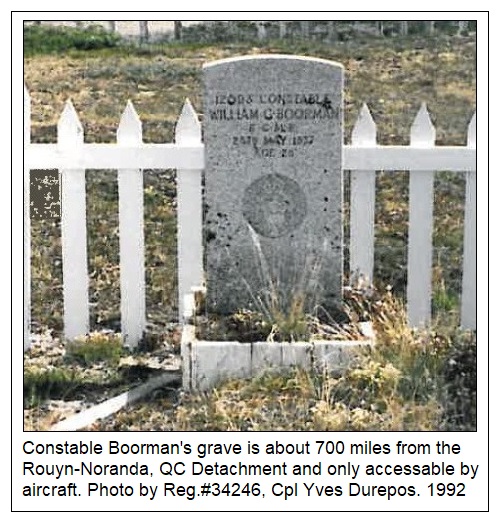
which is located in the Nunavik Region and lies
in the northern third of Québec, Canada
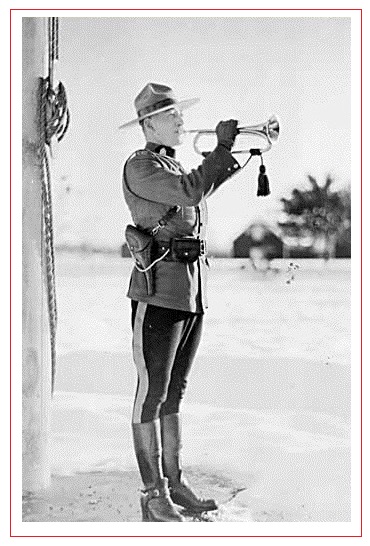
An RCMP photograph - possibly taken at 'Depot' Division.
